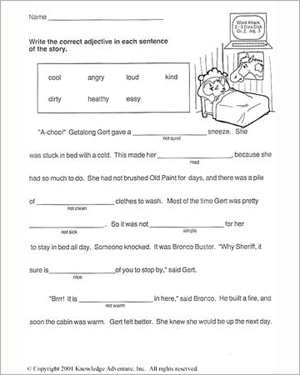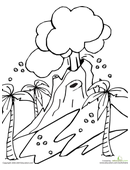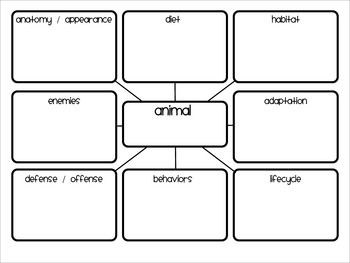Volcano Worksheets Second Grade
Volcano worksheets for second grade students are a fantastic way to engage young learners in Earth science. These worksheets provide a comprehensive introduction to the fascinating world of volcanoes, exploring topics such as volcano anatomy, types of volcanoes, and the impact of volcanic eruptions. By utilizing these worksheets, educators can create a captivating learning experience that promotes both knowledge acquisition and critical thinking skills in their second-grade students.
Table of Images 👆
More 2nd Grade Worksheets
Math Worksheets 2nd Grade ActivitySecond Grade Reading Worksheets Printable
Clock Worksheets for Second Grade
Past Tense Verbs Worksheets 2nd Grade
First Day of School Worksheets 2nd Grade
Main Idea Worksheets Second Grade
Reading Fluency 2nd Grade Worksheets
Second Grade Short Story Worksheet
Being a Good Citizen 2nd Grade Worksheet
What is a volcano?
A volcano is a geological landform where magma, rock fragments, ash, and gases are erupted from within the Earth's crust through a vent or opening in the surface. This process is driven by the build-up of pressure beneath the Earth's surface, leading to an explosive release of volcanic material. Volcanoes can vary in size, shape, and activity levels, and the materials they release can have significant impacts on the surrounding environment.
Where are volcanoes usually found?
Volcanoes are usually found along the boundaries of tectonic plates, known as the "Ring of Fire," which encircles the Pacific Ocean. They can also be found at hotspots within tectonic plates, such as the Hawaiian Islands.
How are volcanoes formed?
Volcanoes are formed when molten rock, called magma, rises towards the Earth's surface. As the magma moves up, it can erupt through the Earth's crust, creating volcanic activity. This can happen at different types of plate boundaries, such as convergent boundaries where tectonic plates collide or subduction zones where one plate is forced beneath another. The magma can also rise up through hotspots in the Earth's mantle or along divergent boundaries where plates are moving apart. Eruptions can vary in intensity and can lead to the formation of different types of volcanoes, such as shield volcanoes, stratovolcanoes, or cinder cone volcanoes.
What are the different parts of a volcano?
A volcano consists of various parts, including a magma chamber where molten rock accumulates, a main vent through which magma rises to the surface, secondary vents that can also release magma, a crater at the summit where eruptions occur, and lava flows that spill out onto the volcano's slopes. Additionally, some volcanoes have features like fumaroles (vents emitting gas), ash clouds, pyroclastic flows, and volcanic bombs that are all associated with volcanic activity.
What are some common features of a volcanic eruption?
Common features of a volcanic eruption include the ejection of hot magma, ash, and gases from the volcano, the formation of a volcanic crater or vent where the eruption occurs, the release of pyroclastic flows that travel down the slopes of the volcano at high speeds, and the potential for lava flows that can destroy surrounding vegetation and structures. Other features may include the production of volcanic lightning, lahars (mudflows), and the formation of volcanic bombs or blocks ejected from the crater.
What are some safety precautions people should take near a volcano?
When near a volcano, people should follow safety precautions such as staying updated on local alerts and evacuation orders, wearing masks to protect against ash and gases, staying out of restricted areas, and having an evacuation plan in place. It is important to be aware of volcanic activity and be prepared to leave at short notice in case of an eruption.
How do volcanoes affect the environment?
Volcanoes can have various environmental impacts, including releasing harmful gases and ash into the atmosphere, which can affect air quality and lead to respiratory issues. The ash produced during eruptions can also disrupt transportation systems and damage vegetation. Additionally, volcanic eruptions can result in the formation of acid rain, which can harm aquatic life and vegetation. The deposition of volcanic ash on land can alter soil fertility and affect agriculture. Furthermore, volcanic eruptions can contribute to climate change by releasing greenhouse gases and aerosols into the atmosphere, leading to global cooling in the short term and potential warming in the long term.
Can volcanoes be beneficial?
Yes, volcanoes can be beneficial in many ways. They create nutrient-rich soil that is excellent for agriculture, support unique ecosystems, and contribute to the Earth's natural processes such as plate tectonics and the carbon cycle. Additionally, volcanic eruptions can release gases that contribute to the Earth's atmosphere and influence climate patterns.
What are some famous volcanoes around the world?
Some famous volcanoes around the world include Mount Vesuvius in Italy, which famously destroyed the city of Pompeii in 79 AD, Mount St. Helens in the United States, known for its devastating eruption in 1980, Mount Fuji in Japan, an iconic symbol of the country, and Mauna Loa in Hawaii, the largest volcano on Earth by volume and a popular tourist destination. Other notable volcanoes include Mount Etna in Italy, Krakatoa in Indonesia, and Cotopaxi in Ecuador.
How do scientists monitor and study volcanoes?
Scientists monitor and study volcanoes using a variety of techniques including seismic monitoring to detect ground vibrations, gas monitoring to analyze gas emissions, satellite imagery to track surface changes, and thermal monitoring to measure temperatures near the volcano. Ground deformation measurements, geophysical surveys, and field observations are also used to assess volcanic activity levels and potential hazards, providing valuable insights for predicting eruptions and mitigating risks to nearby populations.
Have something to share?
Who is Worksheeto?
At Worksheeto, we are committed to delivering an extensive and varied portfolio of superior quality worksheets, designed to address the educational demands of students, educators, and parents.































Comments